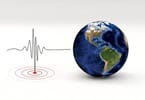After her recent flight arrived in Atlanta, a 57-year-old woman told paramedics she had been throwing up and felt nauseated. A virus had been afflicting her family.
“Everyone in the family has this,” she said.
On any given day, passengers battling contagious illnesses of all kinds pass through Atlanta’s Hartsfield-Jackson International Airport. Some are so sick that paramedics are called to their aid. But airlines routinely let sick passengers fly and rarely comply with regulations requiring that they notify the Centers for Disease Control and Prevention of certain illnesses.
Airlines said it isn’t easy to know who is ill and what to report.
“People who are sick shouldn’t travel,” said Dr. Martin Cetron, director of the CDC’s division of global migration and quarantine. “It’s not good for you and your illness. It’s certainly not good for your fellow passengers.”
But sick people travel anyway. In October and November alone, medics responded to at least 75 reports of people at the airport complaining of vomiting, nausea, diarrhea, fever, sore throat and coughs. Some had most of these symptoms at once, according to Atlanta Fire-Rescue Department records.
One passenger had been sick since she went to California nearly a week earlier, but she still flew to Atlanta, having bouts of vomiting and diarrhea aboard the plane. Another had been sick for two weeks while in Peru, possibly from malaria, she thought. Despite a fever, she flew into Atlanta.
Airline industry officials said their employees aren’t trained medical professionals. How are they to know someone has a fever, unless it’s very high? Besides, they said, an airplane is no more likely to spread disease than any other crowded place.
Airlines can deny boarding to passengers, though none would say how often they do it.
“If somebody arrives for a flight sniffling a bit, it’s not necessarily going to attract attention or suspicion,” said Katherine Andrus, assistant general counsel for the Air Transport Association.
Federal regulations require airlines to immediately notify health officials of any passenger or crew illness involving diarrhea or a two-day fever or any fever with a rash, swollen glands or jaundice before their flight reaches an airport.
The CDC has requested that airlines also report anybody who has a fever plus difficulty breathing, headache with stiff neck, reduced level of consciousness or unexplained bleeding. Such symptoms “may indicate a serious, contagious illness,” the agency says.
While transmission of serious diseases aboard aircraft is believed to be rare, nobody knows how often colds, flu and the stomach bug norovirus are spread among passengers.
John Spengler, an environmental health professor at the Harvard School of Public Health, said close proximity for long periods of time gives airline travel special potential for spreading disease.
“Airlines have very good ventilation,” Spengler said, noting that recirculated air is repeatedly cleansed through HEPA filters on most planes. But there’s no getting around the tight confines of a coach class seat on a packed jet —-and the nasty sick person sitting next to you for hours.
CDC is concerned about identifying and stopping the spread of diseases ranging from measles, tuberculosis and bacterial meningitis, to SARS and rare hemorrhagic fevers like Ebola. Airline reporting is considered critical in responding to an influenza pandemic.
But airlines rarely report ill passengers so the CDC can assess them, said Cetron. “Most of what we learn about is after the fact” such as from hospitals, he said.
CDC doesn’t even get a full reporting of all deaths aboard aircraft, Cetron said.
From January through mid-October, the CDC’s quarantine program received 1,607 reports nationwide of travelers who were sick or died aboard airplanes, ships or other modes of transportation; 100 reports involved the quarantine station at Hartsfield, which serves Georgia, Tennessee and the Carolinas. Most of the cases, after being assessed, didn’t require further CDC intervention.
Last December, a very ill, coughing woman with multi-drug resistant tuberculosis flew from India to Chicago, then to California. One person who flew with her later became TB-positive on tests, though CDC officials said the traveler had lived in a country with a high TB rate, making the source of exposure unclear.
Seven months earlier, Andrew Speaker of Atlanta, who had no outward symptoms or cough, was isolated by federal authorities in a highly publicized incident after he flew to Greece and back with drug-resistant TB. Tests found nobody caught the disease from Speaker.
In 2004, a 38-year-old businessman sick with Lassa fever —-a viral hemorrhagic illness —-flew from West Africa through London to Newark. He had been sick for three days and continued to have fever, chills, sore throat, diarrhea and back pain aboard his flights. The airline did not report the incident to CDC, Cetron said. Within hours of arrival in the United States, the man was hospitalized. He had a temperature of 103.6 degrees and died a few days later.
Again, no passengers were infected. But a few studies have documented cases where serious diseases have been spread aboard aircraft, including tuberculosis, influenza and SARS.
In most cases, the scientific articles involve a single incident. So how often are diseases spread aboard aircraft?
“You ask anybody who flies and they all feel that this environment is the cause,” said Harvard’s Spengler. “But what proof do we have? Unfortunately, we don’t have much proof except for those case studies.”
Spengler is part of the multi-university Center of Excellence for Airliner Cabin Environment Research, which is examining how tiny droplets are spread in jets to devise better decontamination methods for aircraft surfaces.
While the scientific evidence is being gathered, Spengler, like other travel and health experts, takes his own protective measures. “I’m fastidious about washing my hands,” he said. And he uses a paper towel to open the lavatory door.
If a traveler shows signs of being infectious, Spengler cranks up the air nozzle above his seat to blow filtered air in his direction. “I’d rather have that little extra protection than not.”
SICK AT THE AIRPORT
Medics with the Atlanta Fire-Rescue Department respond to about 4,000 emergency calls a year involving people at Hartsfield-Jackson International Airport. The Atlanta Journal-Constitution used the Georgia Open Records Act to obtain the department’s database of reports for 2007 and 2008. The reports don’t give diagnoses, which often require lab work done elsewhere. Here are just a few:
> Sick pilot: In March, a 24-year-old pilot had been battling cold and flu symptoms, including a fever, for a day. He went to work anyway. After landing his plane in Atlanta, he fainted. A flight attendant told medics he was out for one to two minutes. The pilot and the airline were not identified in the data.
> Nasty cough: A 37-year-old man told medics in October he had body pain and was coughing up green sputum. He said he had caught malaria while working in Africa and that doctors had advised him to come back to the U.S. for treatment because his condition wasn’t improving.
> High fever: A 29-year-old man who was suffering from a fever of 102.8, dizziness, nausea and vomiting told paramedics in July he had been diagnosed with a virus five days earlier and he was out of his medication.
> Fainting while waiting: While standing in line at a Delta counter, a 26-year-old man passed out in January, chipping his tooth on the counter as he fell. The man told medics he had been diagnosed with strep throat several days ago and said he still had a fever.
> Possible chickenpox: Customs officials called medics in August to check out a 4-year-old boy who had flown in from Nigeria with his mother, who said he might have chickenpox.
ŠTA MOŽETE UČINITI
“You can’t control what people bring on an airplane, but you can have some control,” said Heidi Giles MacFarlane, vice president of global response services for MedAire, a firm that provides medical consulting to airlines.
Last year MedAire received more than 17,000 in-flight calls from the 74 global airlines it serves.
Travel and health experts advise:
> Don’t travel if you’re sick. Think about other passengers who are particularly vulnerable: People with immune systems weakened by disease, cancer treatment or transplants; very young children and the elderly.
> Tell your airline: Airlines will sometimes allow ill passengers to postpone or change their flight and waive any fees, but they do it on a case-by-case basis and may require a doctor’s note.
ŠTA MOŽETE UČINITI
> Buy travel insurance. At the time you book your trip, purchase insurance that covers the cost of your ticket if you become ill or injured. For trips abroad, get travel insurance that will cover your medical evacuation back to the United States.
> Wash your hands. And do it properly: With soap and warm, running water for at least 20 seconds. Carry an alcohol-based hand sanitizer as a backup.
> Avoid touching surfaces. Not everyone washes their hands in the bathroom —- but they probably grabbed the door handle when they left. Use a paper towel to open the door. And avoid touching other surfaces that may harbor bacteria or viruses, such as airline tray tables and airport ticket counters.
> Ask for another seat. If another passenger is so ill that it makes you uncomfortable, speak up. Alert airline staff, especially before boarding. If the person is seated next to you, ask if you can be moved.
> Get a flu shot. With peak flu season approaching, it’s still not too late.
> Know the local diseases. If traveling to other countries, you may need other shots or medicines to protect you. The CDC has detailed advice at: wwwn.cdc.gov/travel/default.aspx
ŠTA UZIMATI IZ OVOG ČLANKA:
- Federal regulations require airlines to immediately notify health officials of any passenger or crew illness involving diarrhea or a two-day fever or any fever with a rash, swollen glands or jaundice before their flight reaches an airport.
- One person who flew with her later became TB-positive on tests, though CDC officials said the traveler had lived in a country with a high TB rate, making the source of exposure unclear.
- But there's no getting around the tight confines of a coach class seat on a packed jet —-and the nasty sick person sitting next to you for hours.






















